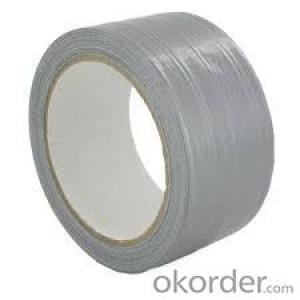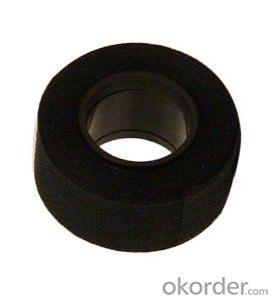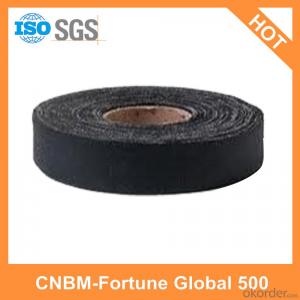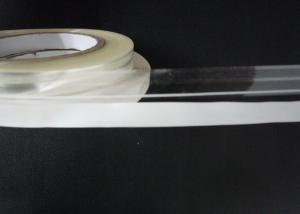Sushi Packaging Tape - Natural Rubber Cloth Tape for Pipe Wrapping
- Loading Port:
- Shanghai
- Payment Terms:
- TT OR LC
- Min Order Qty:
- 50 roll
- Supply Capability:
- 500000 roll/month
OKorder Service Pledge
OKorder Financial Service
You Might Also Like
Quick Details
Carrier:polyethlylene cloth
Color:black,white,blue,green,yellow,red,brown and silver
Mesh:from 27 mesh to 70 mesh
Adhesive:hot-melt adhesive,synthetic rubber adhesive,natural rubber
Type:normal duct tape for pipe wrapping;gaffers tape;book binding cloth tape;cotton cloth tape
Applications
normal duct tape for pipe wrapping
gaffers tape
book binding cloth tape
cotton cloth tape
Advantages:
Multicolor, available in a wide range of color
Humidity resistance, superior resistance to heat and water
High flexibility and strong tensile strength promote durable properties
Excellent adhesion characteristics and high strength for bonding results
PACKING:
Cut Roll: As per customer’s requirements
About Us
CNBM International Corp.,established in 2004,is the business entity for trade and logistics of CNBM Group,a state-owned company under the direct supervision of State-owned Assets Supervison and Administration Commission of the State Council of People's Republic of China.
Adhero is the adhesive tape division of CNBM International Corporation.Over the past decade we have been developed into a leading manufacturer of adhesive tapes in China.We mainly supply various kinds of adhesive tapes as BOPP packing tape,cloth duct tape,double sided taps,PVC tapes,Aluminum foil tape etc.



- Q: Can packaging tape be used for mailing packages?
- Yes, packaging tape can definitely be used for mailing packages. It is specifically designed to securely seal packages and ensure they stay intact during transit. Packaging tape is strong and durable, making it ideal for securing boxes, envelopes, or other types of packaging materials. It is commonly used in shipping and mailing applications and is available in various sizes and strengths to accommodate different package sizes and weights. Whether you are sending a small envelope or a large box, packaging tape is an essential tool to ensure your package is properly sealed and protected during the mailing process.
- Q: Can packaging tape be used for sealing household or kitchen items?
- Yes, packaging tape can definitely be used for sealing household or kitchen items. It is a versatile adhesive tape that is commonly used for sealing cardboard boxes, but it can also be utilized for sealing various items in the household or kitchen. Whether you need to seal food containers, plastic bags, or even small appliances, packaging tape can provide a strong and secure seal. It is important to ensure that the surface is clean and dry before applying the tape to maximize its adhesive strength.
- Q: Is packaging tape safe to use on plastic cutting mats?
- Packaging tape is generally safe to use on plastic cutting mats, but it is important to consider a few factors before using it. Firstly, ensure that the plastic cutting mat is made of a durable and food-safe material. Some low-quality plastic cutting mats may be prone to scratching or tearing when adhesive tape is applied, so it is advisable to check the manufacturer's recommendations or guidelines. Secondly, consider the purpose of using packaging tape on the cutting mat. If it is for temporary storage or transportation, packaging tape can be suitable as it provides a secure seal. However, if the tape will be in direct contact with food or used during food preparation, it is recommended to avoid using packaging tape. Adhesive residues from the tape may transfer onto the food or contaminate the cutting surface, which could pose a health risk. In such cases, it is better to use food-grade or specialized tape that is specifically designed for use with cutting mats or food preparation surfaces. In conclusion, while packaging tape can be safe to use on plastic cutting mats, it is crucial to consider the quality of the cutting mat, the purpose of using the tape, and potential food safety concerns. Always prioritize the safety and hygiene of your food preparation surfaces when choosing the appropriate tape.
- Q: Can packaging tape be used on different materials?
- Yes, packaging tape can be used on different materials. Packaging tape is versatile and can adhere to a wide range of surfaces, including cardboard, plastic, metal, glass, and even fabric. It is designed to provide a strong and secure seal, ensuring that packages remain intact during transportation and storage. Whether you are sealing a cardboard box, bundling items together, or securing a package, packaging tape is an effective choice for various materials.
- Q: How do I prevent packaging tape from getting tangled?
- Here are several suggestions to prevent packaging tape from becoming tangled: 1. Invest in a tape dispenser designed specifically for packaging tape. This dispenser incorporates a built-in cutting blade and roller mechanism that will help maintain control over the tape and prevent tangling. 2. Before applying the tape, ensure that the surface is clean and free of dust, debris, or any other potential obstructions that could cause the tape to stick and tangle. 3. Minimize handling of the tape as much as possible, as each time it is touched, there is a greater likelihood of it twisting or tangling. Handle the tape only when necessary. 4. Use a sharp cutter or a dispenser with a cutting blade to make clean and straight cuts. Uneven or jagged cuts can cause the tape to twist or tangle as it is unrolled or applied. 5. Store the tape properly when it is not in use. Keep it in a cool and dry place, away from direct sunlight or extreme temperatures. Additionally, keeping the tape in its original packaging or a designated container can help prevent tangling. 6. When unrolling the tape, hold the roll firmly and apply a slight tension to keep it straight. Avoid jerky movements or pulling the tape too forcefully, as this can cause it to twist or tangle. By following these suggestions, you can reduce the likelihood of packaging tape becoming tangled, resulting in a smoother and more efficient packaging process.
- Q: Can packaging tape be used for sealing camping or outdoor gear?
- Yes, packaging tape can be used for sealing camping or outdoor gear. It is strong and durable, providing a temporary seal for items such as tents, sleeping bags, and backpacks. However, for longer-term or more permanent seals, it is recommended to use specialized outdoor repair tapes or adhesives designed for outdoor gear.
- Q: Does packaging tape come in different adhesion levels for various surfaces?
- Packaging tape is available in different adhesion levels to suit various surfaces. The market offers a range of packaging tapes, each tailored to adhere to specific surfaces. For instance, there are packaging tapes with low adhesion levels, perfect for delicate surfaces like paper or cardboard. These tapes provide a strong bond without causing any damage when removed. Conversely, high adhesion packaging tapes are specially formulated to stick to rough or uneven surfaces such as plastic or metal. These tapes have a more powerful adhesive to ensure a secure hold, even in challenging environments. Moreover, there are packaging tapes with medium adhesion levels that offer versatility and can be used on a variety of surfaces. The availability of different adhesion levels allows users to select the most suitable packaging tape for the specific surface they need to adhere to, ensuring optimal performance and reliability.
- Q: What's the tape for sealing tape?
- BOPP film can be produced by tube or flat film method. The BOPP films obtained by different processing methods have different properties. The BOPP film produced by the flat film method has a higher strength ratio (up to 8-10), so the strength is higher than that of the tube film, and the uniformity of the film thickness is better.
- Q: How does packaging tape perform on porous surfaces?
- When it comes to porous surfaces, packaging tape shows decent performance, even though its adhesive strength might be slightly compromised compared to non-porous surfaces. This tape is specifically designed to stick to a variety of surfaces such as cardboard, paper, and fabric, all of which are commonly known as porous materials. However, because these surfaces are porous, some of the adhesive may seep into the material, resulting in a reduction in bond strength. Moreover, the tape may not stick as firmly to porous surfaces, which makes it more likely to peel or lift. To ensure maximum adhesion, it is recommended to make sure the surface is clean and dry before applying the tape.
- Q: Can packaging tape be used for sealing plumbing or pipe fittings?
- No, packaging tape should not be used for sealing plumbing or pipe fittings. It is not designed for this purpose and may not provide a secure and durable seal. It is best to use appropriate plumbing sealants or tapes specifically designed for plumbing applications to ensure proper sealing and prevent any leaks.
Send your message to us
Sushi Packaging Tape - Natural Rubber Cloth Tape for Pipe Wrapping
- Loading Port:
- Shanghai
- Payment Terms:
- TT OR LC
- Min Order Qty:
- 50 roll
- Supply Capability:
- 500000 roll/month
OKorder Service Pledge
OKorder Financial Service
Similar products
Hot products
Hot Searches
Related keywords


























